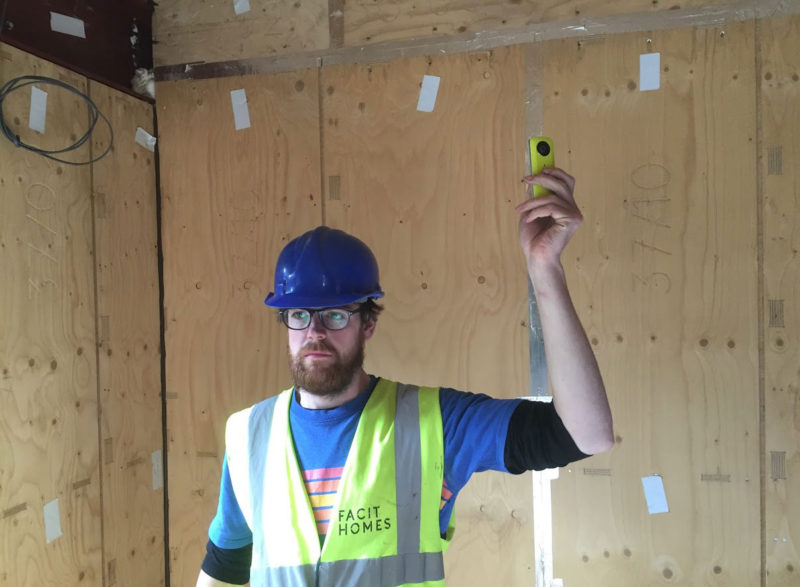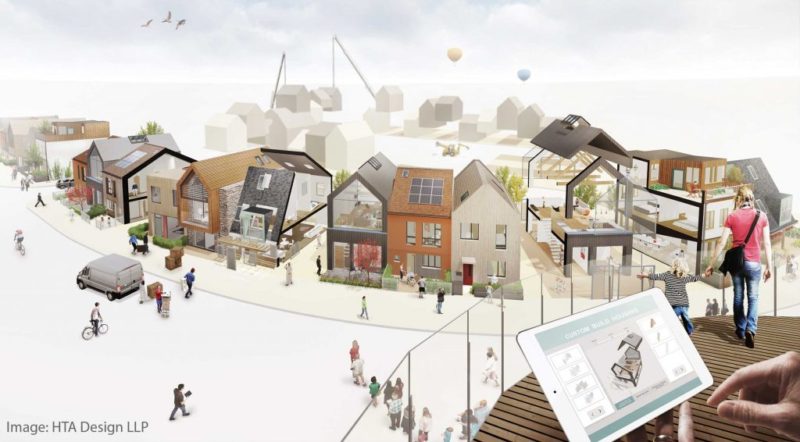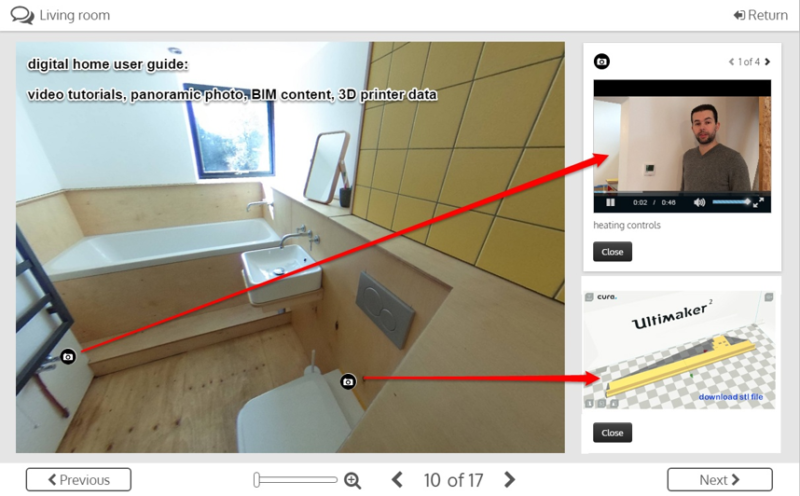
Archive: Digitising Custom Build
The Digitising Custom Build (DCB) project was a collaborative R&D project developing digital tools and methods to help those wanting to buy, design, build and live in a custom build home, that ended in September 2016.
Digitising the industry
The Digitising Custom Build (DCB) project was a collaborative R&D project developing digital tools and methods to help those wanting to buy, design, build and live in a custom build home, that ended in September 2016.
The 18 month collaborative R&D project ended in September 2016 but the technology developed throughout the project will be carried on by the project partners, including at a live site in the Heartlands, Cornwall.
Funded by Innovate UK, this project involves seven partners: NaCSBA, Stickyworld, HTA Design LLP, Axis Design Architects, Facit Homes, Commusoft and Slider Studio.

Why digitise Custom Build homes?
One of the biggest barriers facing the UK’s custom build market and its ambitions to scale up is how we manage the complexity of the process – how to build in choice at every stage, from planning to design to construction, sales and beyond.
Technology is good at solving and simplifying complex processes, and could help to make custom build more accessible to the mainstream housing market.
See how the Digitising Custom Build (DCB) team has developed the technology and processes over the 18 month project…
Digitising Custom Build is a collaborative R&D project that focused on developing digital tools and methods to help those wanting to buy, design, build and live in a custom build home. The tools will help housing professionals and their customers to better manage the planning and design, customisation and sales, onsite construction and post-completion handover stages of new custom build homes.
The technology developed throughout the project aims to unlock creativity and facilitate the growth of a large scale custom build housing market in the UK, such as you see elsewhere in Europe and most of the developed world.
Applications
Can you imagine a future where you have genuine choice and control in the planning, design, style and configuration and construction of your own home?
The project has looked at how digitising the custom build process can provide the opportunity for home buyers to make real choices about the homes they’re investing in.
Take a look at the technology developed throughout the project to enable discussion and unlock creativity and value at every stage.
Slider Studio and HTA Design LLP have trialled the use of CAD software plugins (for use with software such as Revit and SketchUp) at the master planning stage, to help urban designers and architects illustrate scenarios for planners and landowners thinking about or planning a custom build site.
Using the new digital tools, designers can quickly populate a custom build master plan with house types and can test multiple scenarios. This use of the tools is aimed more at the professional user and helps to improve planners’ understanding of custom build and speed up granting of planning permissions.
Research has also been conducted into how the tools will work within a design code to deliver custom build. The partners have explored how a software tool could be developed to take design code guidelines into account when placing house types on a master plan that is subject to particular constraints.
Stickyworld has provided the publishing platform for this functionality. This includes online ‘consultation rooms’ for engaging local communities and showing planners the evidence and results of community involvement and consultation.
HTA Design LLP and Slider Studio have worked together to create cloud-based tools that help developers and manufacturers present choices to home buyers.
Hosted within a highly adaptable online environment created by Stickyworld, ‘design review rooms’ will help all parties work together on the customisation process.
The house configurator will enable customers to select a housetype of their choice from a digital catalogue and then make changes to it on their screen. It will allow them to assess for themselves how the different options available will work for them.
The prototype demonstrates how an interface can inform the home buyers of the implications of their choices. They can see all the relevant metrics that may affect their final design decisions such as cost and lifestyle benefits.
The intention of the technology is not to create a final piece of software, but do create a working prototype that other custom build designers and developers can adapt and use on their projects.
HTA Design and Kingspan Potton have worked with Slider Studio on a pilot at Heartlands, Pool, Cornwall.
The technology that can help the marketing and sale of custom build homes is similar to that used during planning, design and customisation stages.
Slider Studio and HTA’s digital tools show how cutting edge technology can be used to complement an effective sales campaign.
Home buyers can see the implications of their choices, for example:
Where certain decisions increase or decrease the cost
Impact on lifestyle benefits
Change the potential running costs of the dwelling.
Stickyworld has provided the innovative publishing platform for this functionality – including ‘show rooms’ for marketing homes, getting leads from potential customers and researching their needs and preferences, and ‘sales rooms’ to help custom build sales negotiators finalise specifications, contracts and manage the sales process with customers from start to finish.
Facit Homes has used digital tools to refine its process for generating construction information.
It has improved the digital connection between office and building site, and has trialled the use of 360 degree photography as a way of sharing progress and monitoring construction quality from a remote location.
Facit Homes 360 photography on site
Using a 4G connection with its building sites, information such as 3D models, drawings, photographs and queries can be instantly shared and stored. This has significantly improved the communication between design, manufacturing and onsite construction teams.
Stickyworld has created online ‘site inspection rooms’ to allow all parties to discuss and manage progress on site and to resolve queries during the build.
POST-COMPLETION
Stickyworld, Commusoft and Axis Design Architects have created the Connected Home User Guide. This is being tested at a home in Wolverhampton.
The Connected Home User Guide will enable custom build developers, their designers and agents to create interactive multimedia content about a completed home using several sources including:
Plans
Manuals
Photos
Videos
360 degree virtual tours
BIM generated content
The guide can be adapted throughout the design and build process, resulting in a secure cloud-based information source that makes it really easy for the home owner or tenant to understand their property and to manage it responsibly and sustainably.
The guide allows homeowners to ask questions, get answers and report problems about the performance of the home. It connects the custom build developer to the home owner and it also connects with Internet of Things (IoT) enabled devices in the home, such as thermostats, lights and household appliances, to add relevant data in use.
Additional layers of information about the home’s current energy performance and online access to IoT devices make the user guide a live interface to encourage regular care of the home. Information for the creation of replacement parts using 3D printing technology will help to make the long term maintenance easier without having to depend on proprietary products.

The idea is to present a more meaningful, visual and interactive home user guide, providing rich visual information about a complex modern home. It informs any viewer of how the home has been designed and constructed and explains the services connected to the cloud.
The benefit for custom build developers is that they can offer an up-to-date and lasting resource for home buyers and an efficient communication channel to contact them through if there are any problems following handover. The connectivity and performance information from the home helps drive down energy costs and ensures the home can be managed safely and sustainably. Occupiers feel a sense of ownership of the systems used in the house and they are more likely to understand how they work.
Commusoft worked on the IoT element of the Connected Home User Guide. It has helped to underpin the infrastructure around connected devices. The end goal was to investigate how connected devices can be integrated so that installers, contractors and service engineers could get instant notifications when customers’ appliances either have broken down or are showing signs of a potential problem.
As with the other technologies, Stickyworld provided the publishing platform for this functionality. Stickyworld software hosts the Connected Home User Guide through its well-established ‘room’ format, including ‘training rooms’ where homeowners can be helped to understand how their home works and its maintenance needs.
The pilots
The technology and processes developed through out the Digitising Custom Build project have been tested on sites and projects across the UK.
These pilot studies have allowed the project partners to evaluate how custom build can be up scaled to make it a contender in the mainstream housing market in the UK .
See how the House Configurator and Connected Home User Guide have been tested on these live sites in Cornwall and the Midlands…
HEARTLANDS, POOL, CORNWALL

This pilot study is being carried out in the first phases of a Government-supported custom build housing pilot scheme by Carillion igloo at Heartlands in Pool, Cornwall.
The 144-home development includes 54 custom build houses designed by six different ‘home manufacturer’ teams (comprising of architects, manufacturers and builders).
HTA drawing of the Heartlands
The tools being tested on the Heartlands site have been developed by Slider Studio and HTA Design LLP. They are using CAD and web plug-ins to create a house configurator that will help architects and developers in various ways.
This house configurator will:
Allow architects to model and test custom build home designs.
Help sales staff present choice to home buyers during the sales process
Let home buyers explore their options via a web based version of the same tool
HTA also developed the masterplan for this pilot project as well as developing a range of custom build housetypes with Kingspan Potton, one of the home manufacturers at Heartlands.
WOLVERHAMPTON

Stickyworld, Axis Architects and Commusoft are testing the Connected Home User Guide software on a private property in Wolverhampton.
Speculating on a future of construction and product information improved by the use of BIM, online storage and rapid prototyping material techniques, the guide will curate all the design and construction details about the house in formats aimed to improve the experience for different users.
Drawings, manuals, product receipts, photos, videos, 3D printer files and BIM data will be presented via an online portal using Stickyworld allowing the home owner, landlord or visitor to access maintenance tutorials, material details and object data.
Connected Home User Guide
Additional layers of information about current energy performance and online access to Internet of Things devices will make the user guide a live interface to encourage regular care of the home.
Information for the creation of replacement parts using 3D printing technology will help to make the long term maintenance easier without dependencies on proprietary products.
Partner blogs
Why collaboration is the secret to success for custom build developers
Michael Kohn, Stickyworld
How will the internet of things affect the way we interact with our future homes?
Jason Morjaria, Commusoft
How to build your own house configurator tool
Renee Puusepp, Slider Studio
How can digital tools improve the post-completion handover?
Rob Annable, Axis Design Architects
Industry engagement with technology is the key to custom build at scale
Michael Kohn, Stickyworld
How are HTA Design is approaching the digitising custom build project
Rory Bergin, HTA Design LLP
